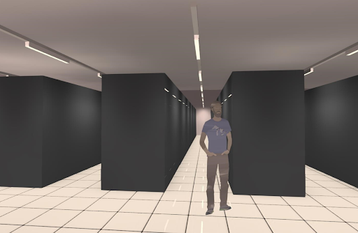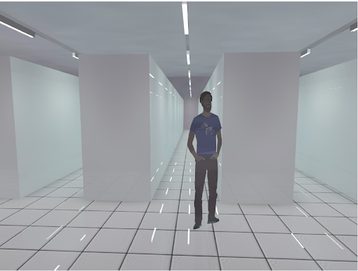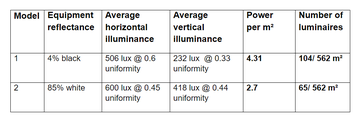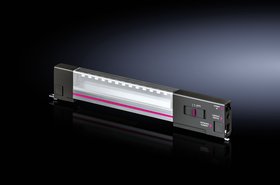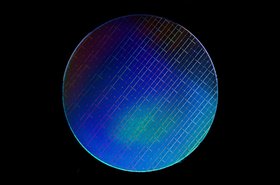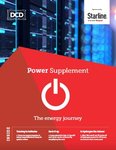For data center operators, energy efficiency is the primary objective, as any specifier working on a mission critical facility knows to be true. But what if you knew another way to optimize the efficiency of your facility and cut your costs without purchasing more products? After all, any positive impact on your PUE (power utilization effectiveness) must be good news, right? Well, those extra savings may just be found in a place where you least suspect. In fact, the color of racking has a direct impact on a data center’s lighting energy consumption and, ultimately, the operator’s bottom line.
When light shines on a black surface, the color appears saturated and absorbs more lumens. White, on the other hand, has a significantly higher reflectance value, meaning more light is distributed throughout the space and, crucially, requires a lower lumen package to achieve the TIA recommended lux levels for data centers.
White is the new black
Black is the most common finish for IT equipment in data halls but, unfortunately, this color actually works against producing an optimized lighting design within a data hall. This is because, to overcome the inefficient light reflectance of a black surface, the only solution is to use more luminaires (electric light units) with higher connected loads, which in turn, leads to increased capital expenditure and higher operating cost.
If you were designing the interior of a data center and chose to opt for white racking instead of black, the number of luminaires required could be reduced by up to as much as 37 percent.
Additionally, there would potentially be another 37 percent of savings realized in the energy used for lighting. So not only do you save at the design stage where you need fewer luminaires to achieve the same lux levels, but you also save the energy which those luminaires would have consumed throughout their lifecycle. That’s a lot of savings in both the short and long term.
Zumtobel lighting has extensive experience and, in data center applications, we are inevitably asked the question, ‘why do I need so many luminaires?’ That’s when we begin the racking color conversation. Imagine if the walls of your home were painted black. Even with identical sources of natural light, it’s the same principle - you require more luminaires to achieve the same levels of light.
Sustainable sourcing
We know that the EU wants data centers to be carbon neutral by 2030 but despite the increasing pressure on operators, part of this responsibility lies with the industry’s suppliers – to ensure that their products are not just as energy efficient as possible but also sustainably sourced. After all, it’s no good producing an energy saving product if part of that process involves components that contribute to high levels of waste or, in some cases, hazardous by-products.
In an industry which prizes energy as an incredibly valuable resource, it’s no surprise that green building certifications are so widespread, with most new builds targeting gold or silver as standard. To increase transparency, Zumtobel offers Environmental Product Declarations which traces the ecological footprint throughout the manufacturing process - from sourcing the raw materials to packaging the finished product. EPDs can be used to support the selection and specification of products for the construction of sustainable buildings and third-party certifications.
Flexible infrastructure
In order to achieve the most reliable lighting solution, consider the infrastructure next. Does your system come in different configurations and sizes to allow for different layouts? Does it reduce the amount of wiring points for a contractor and allow for faster installation times? Is it possible to mount and install additional luminaires at any time? Flexibility is important especially when the demands of a modern data center are changing due to new technologies and increasing pressure on IT services globally. Asking these questions at the planning stage gives you a competitive advantage and ensures your design will last for many years to come. As operators know too well, technology can become outdated rather quickly and lighting is no exception. By incorporating a flexible intelligent lighting system, this reality becomes much more manageable.
In addition to LED panels, tubes, battens and high bay lighting, continuous row solutions are available that are tested and approved for use in higher ambient temperatures. This not only lowers the running costs of a lighting scheme when compared to traditional compact fluorescent lighting technology, but also reduces the operating costs of a cooling strategy, which plays an important role in achieving a low PUE rating. However, it is important to remember that lighting must be specific to the aisle layout and built to order, so enough light is available on the vertical of each rack.
Regardless of the amount of energy being consumed by lighting, for optimal efficiency, it’s important to consider the distribution of light.
Controls for a complete solution
Providing area specific lighting precisely when and where it is needed is an important design consideration. All too often lights are turned on manually across a large space when an operative might only need to work in one small section of a data hall.
Additional energy savings of at least another 10 percent can be achieved with innovative lighting control, which integrates LED luminaires with sensors to manage when and where lighting is deployed.
A site specific lighting control system that uses the well-established DALI protocol enables each area to be autonomous. This further reduces operational expenditure by allowing lighting to be integrated into a building management system (BMS), with the benefit of off-site monitoring. Just as importantly, this level of integration and engagement allows an end user to actively monitor energy consumption and performance from a central point of reference.
This article is based on a report produced by Sophie Parry, Technical Education & Applications Specialist at Zumtobel Lighting


